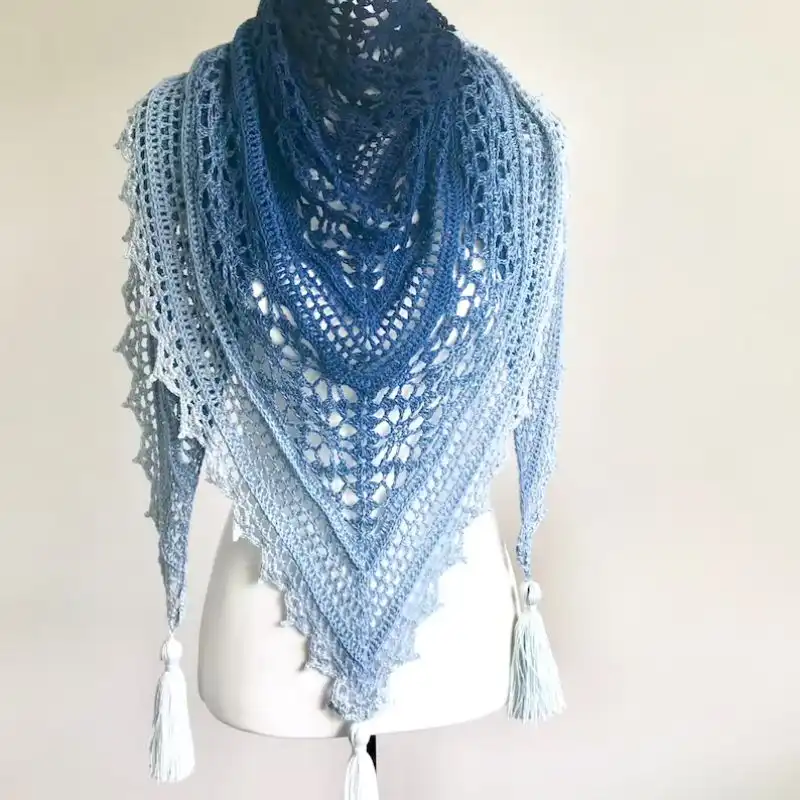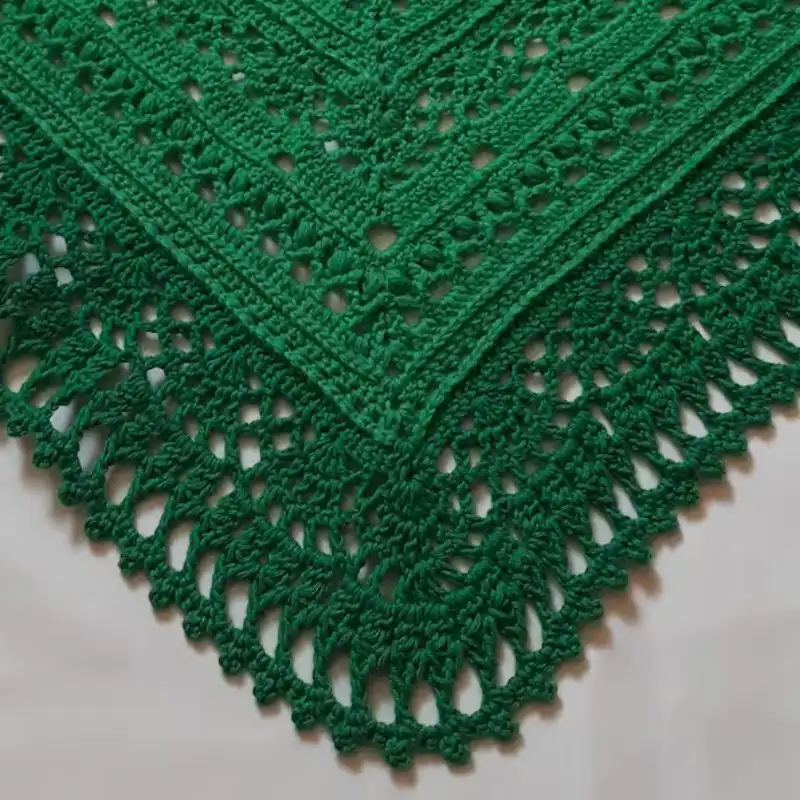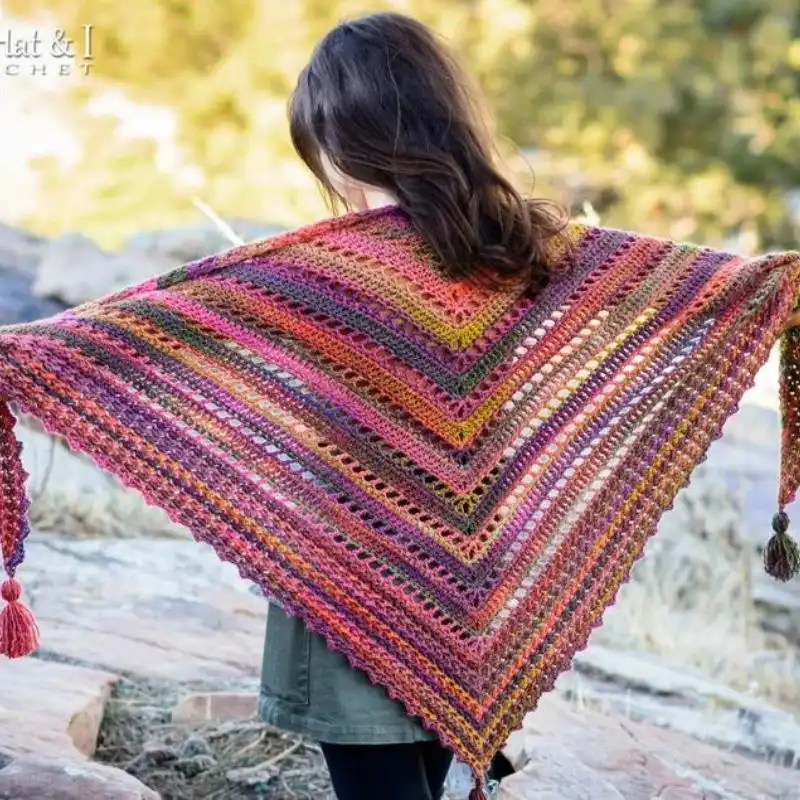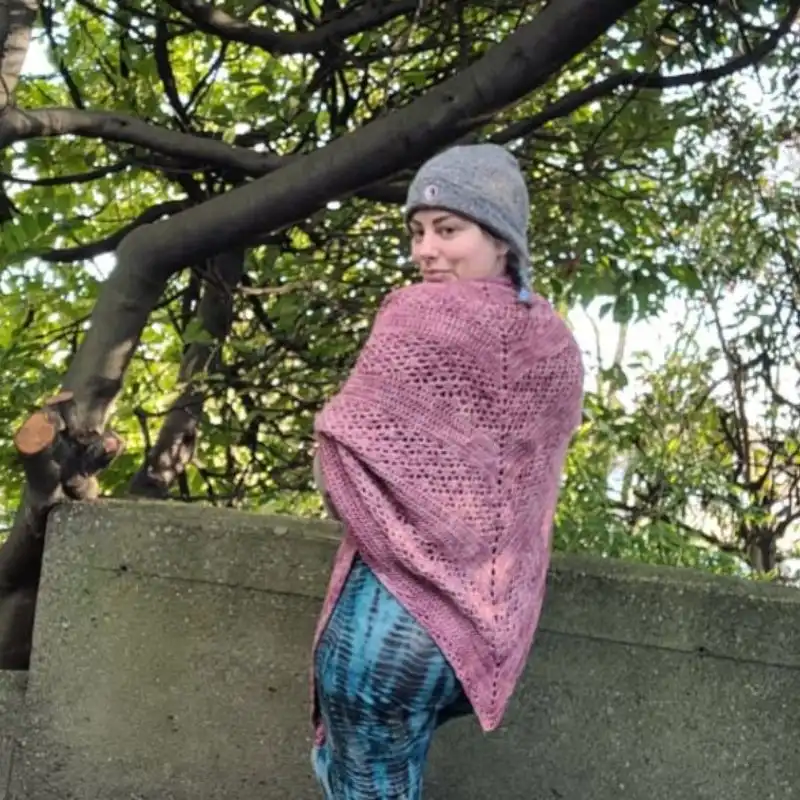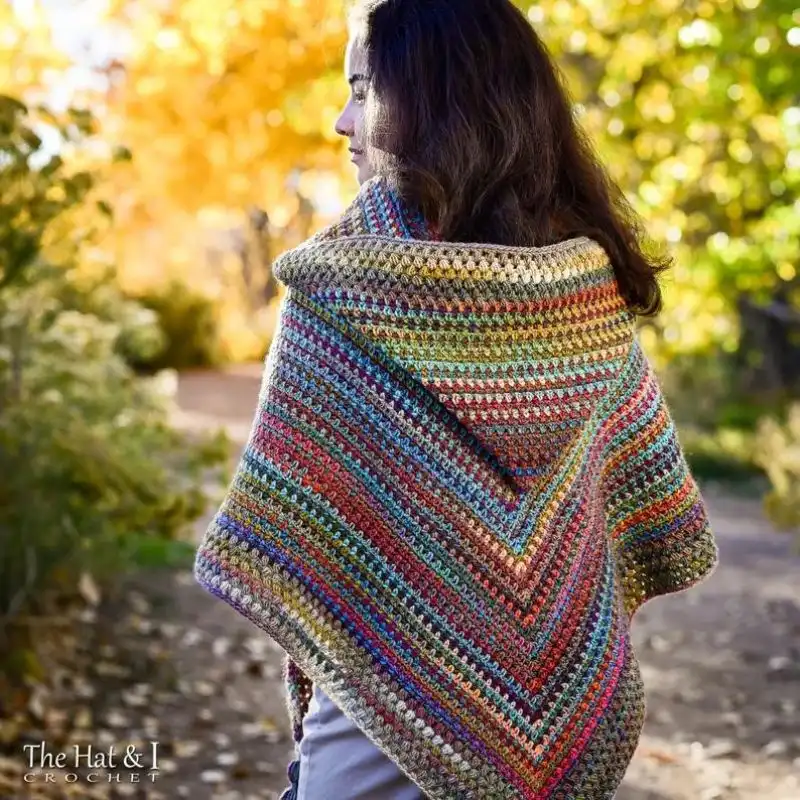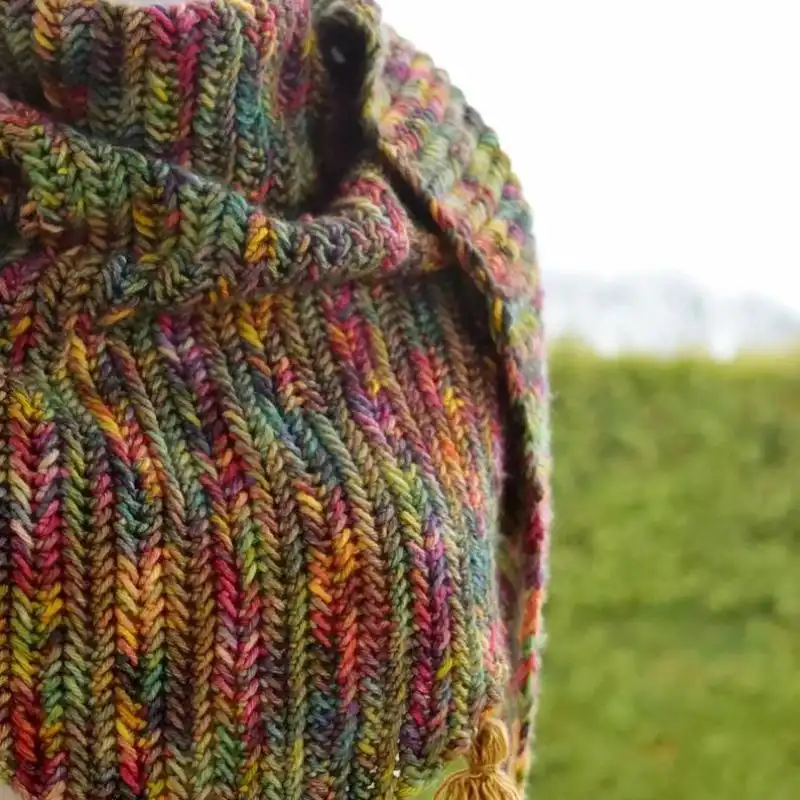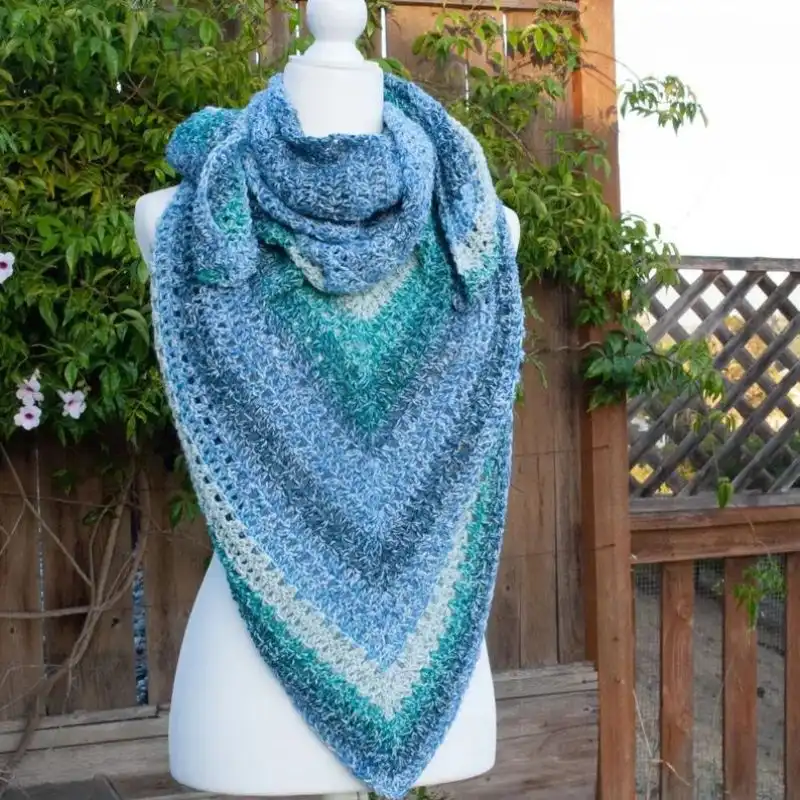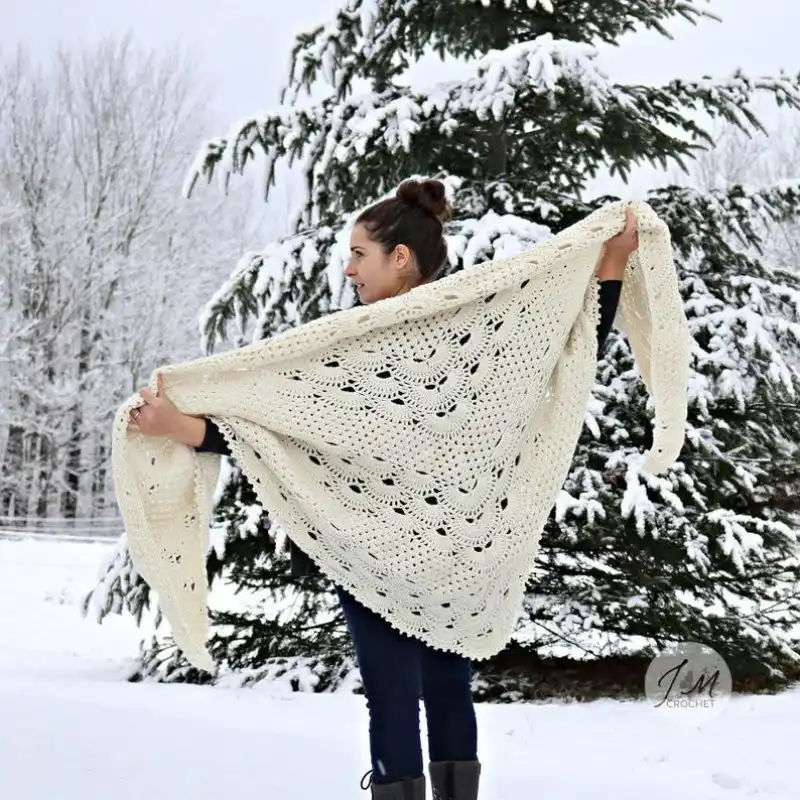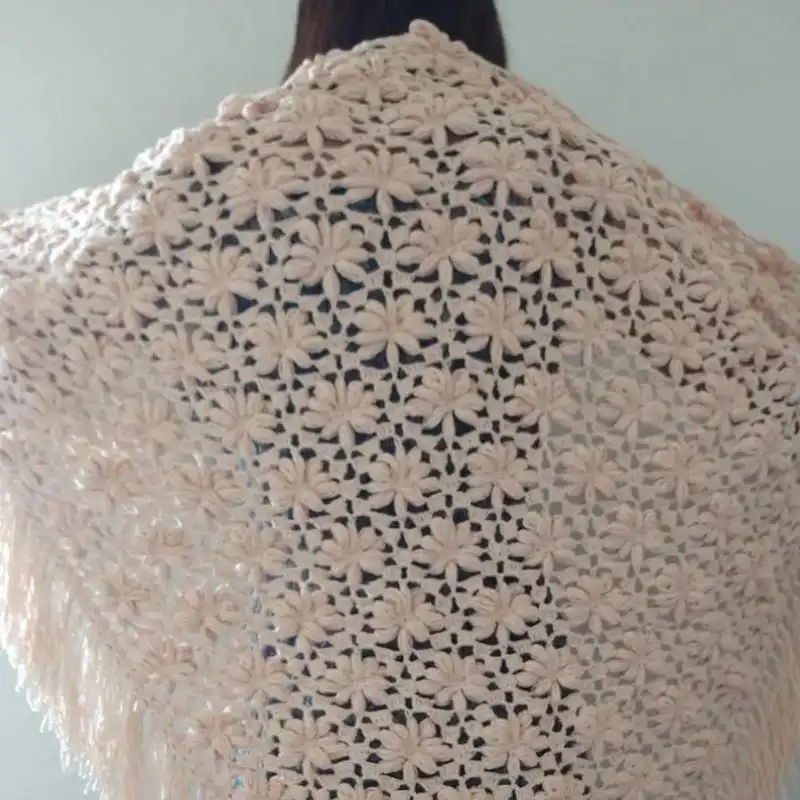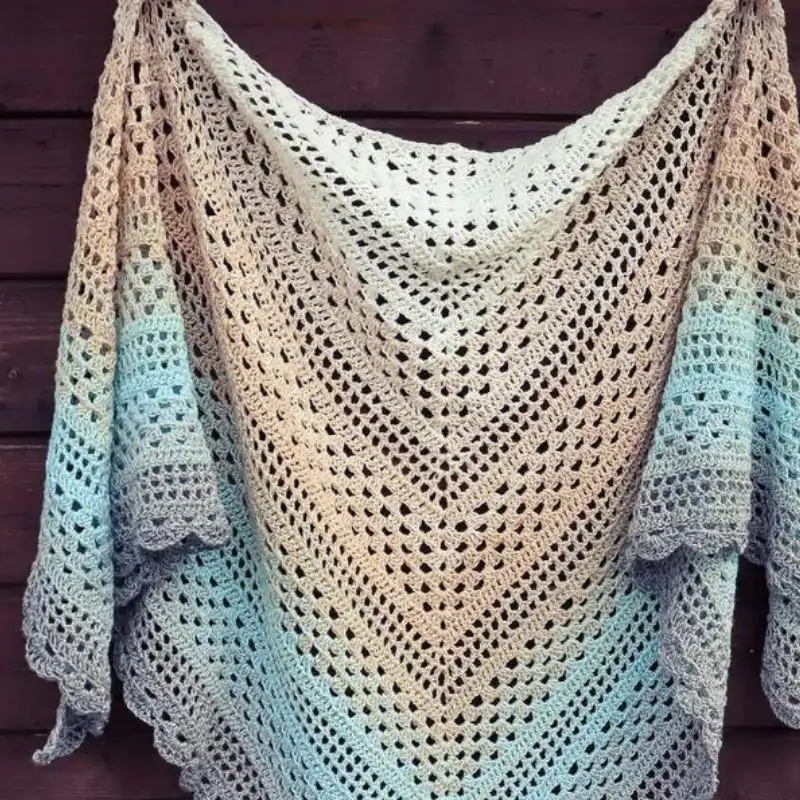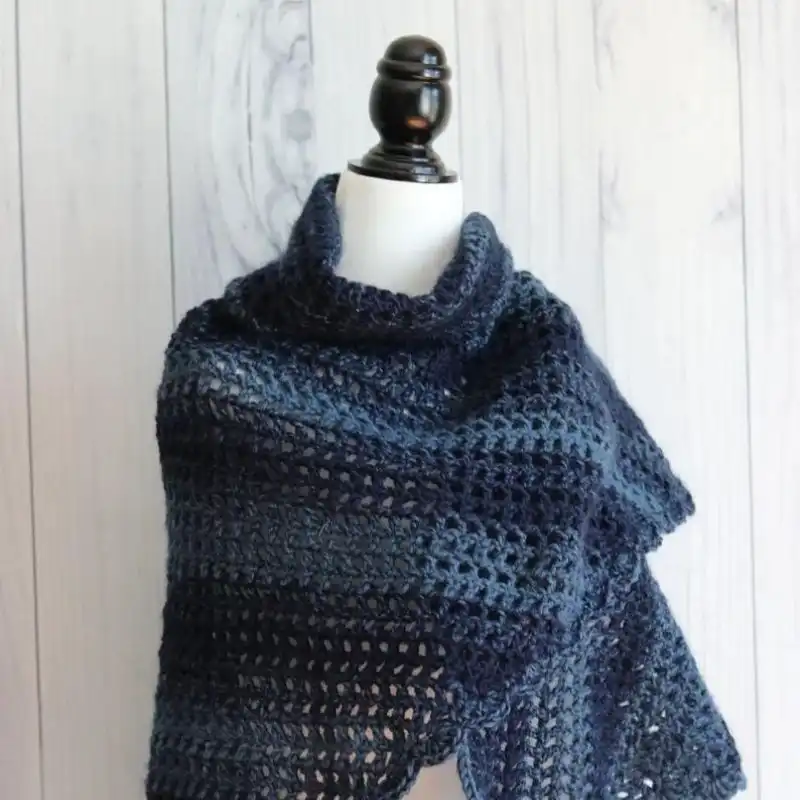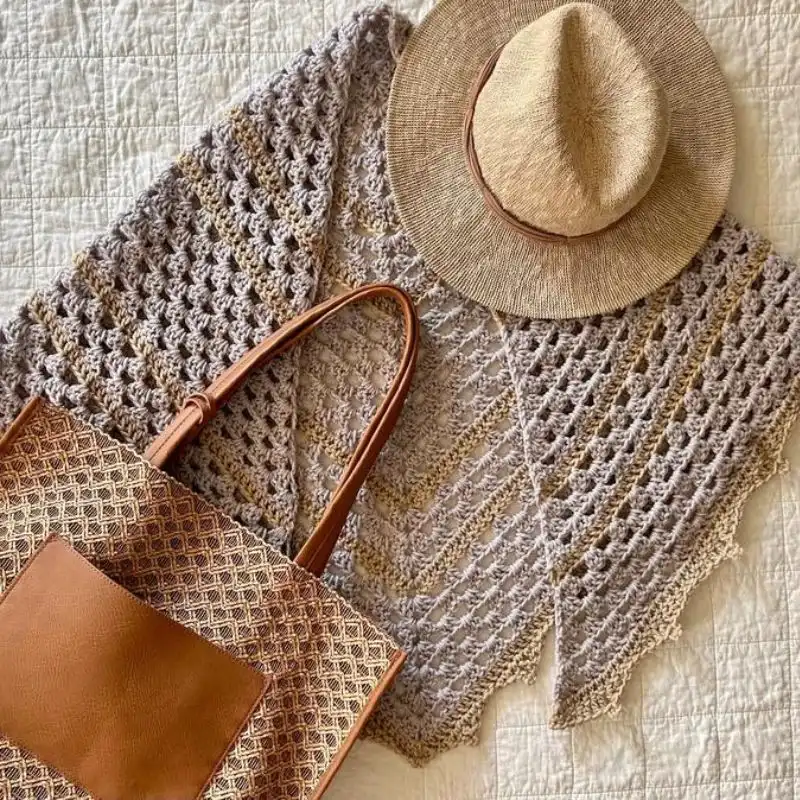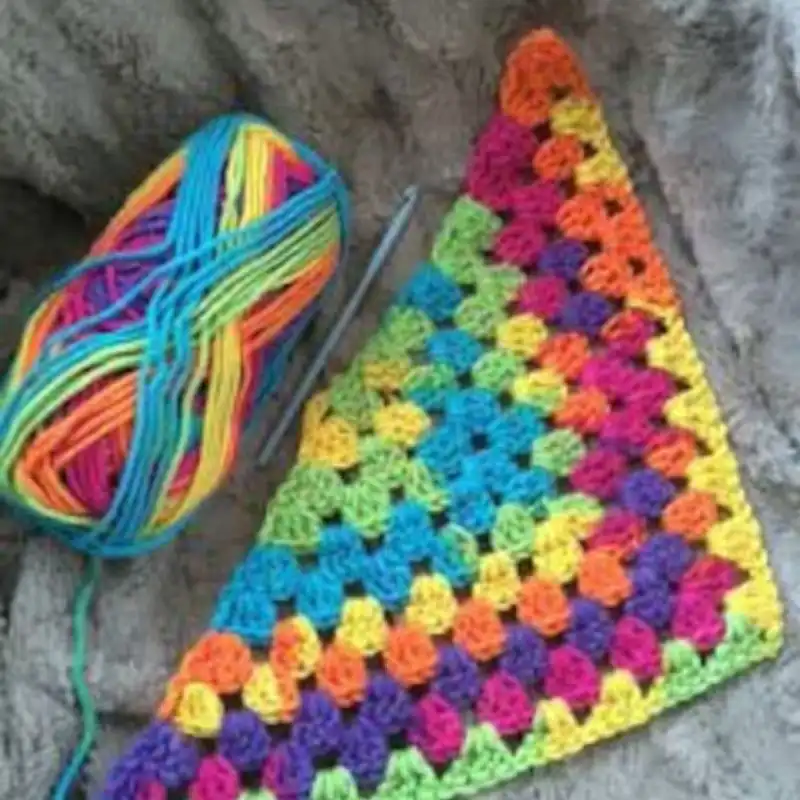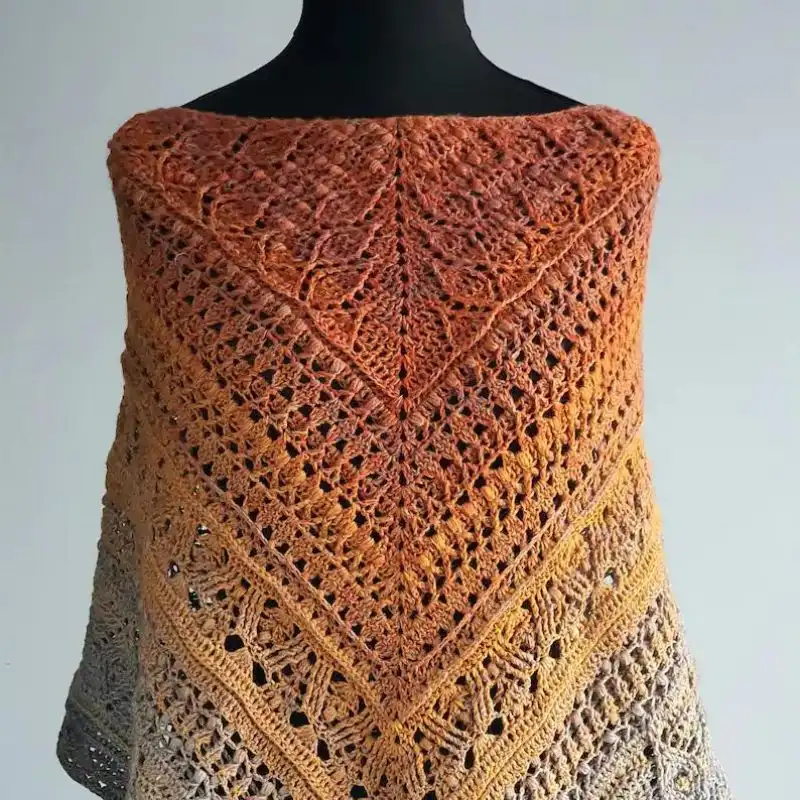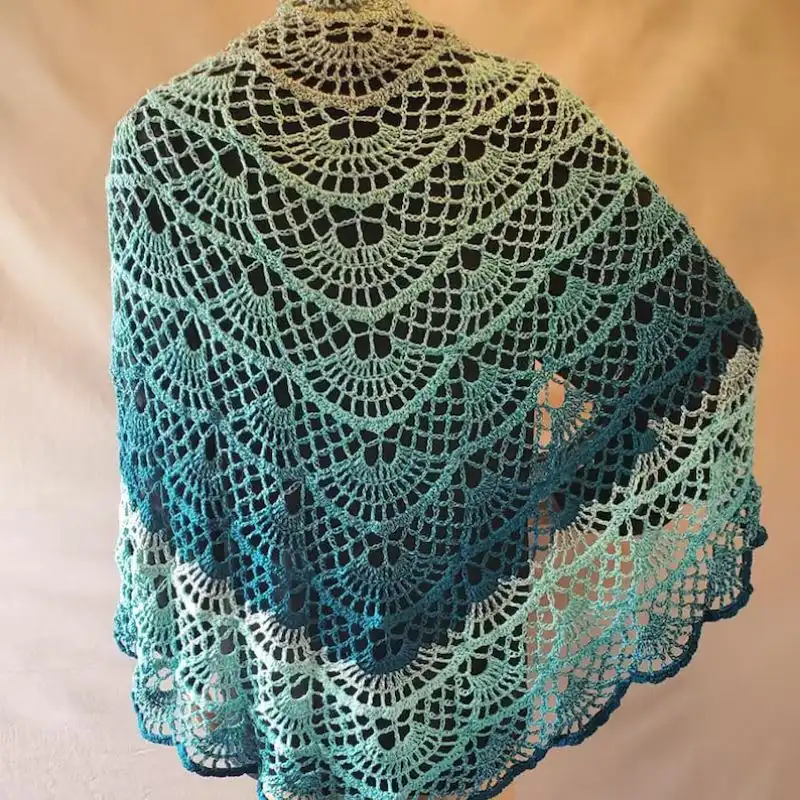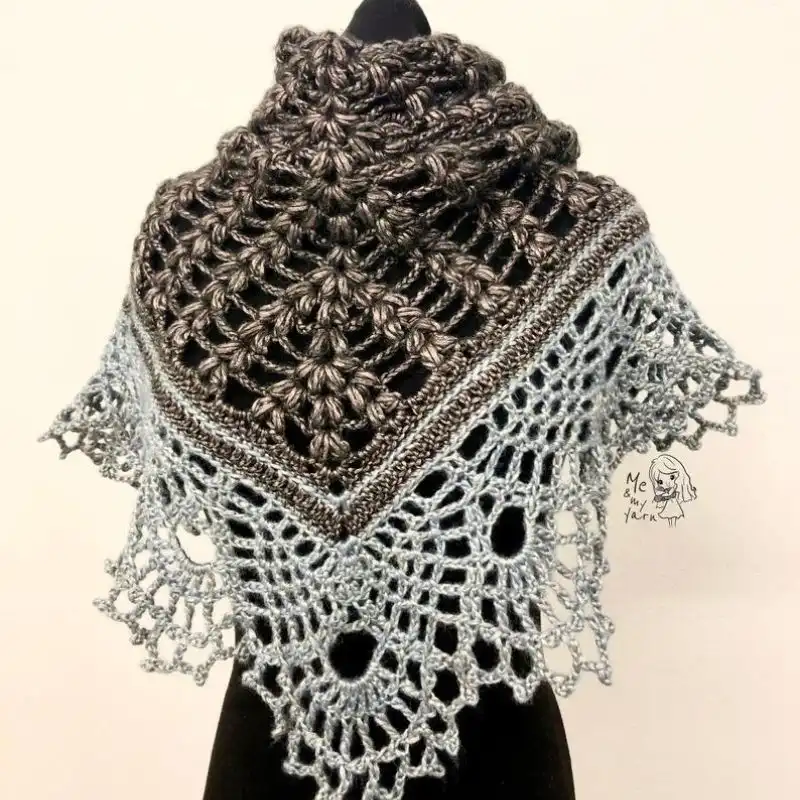Throughout this article, we’ll be making the best recommendations for the best crochet triangle shawl patterns to guide you through your crochet journey in the most efficient way.
Whether you’re a beginner in the world of yarns and patterns, or you’re an expert looking for a new challenge to take up, there’s something in this article for you!
Crocheting can be such a rewarding experience for anyone interested in adding a new skill set to their life. They make great gifts for yourself or friends and family as well as something to keep your mind and body in a peaceful, relaxed state.
Have you ever watched a grandparent watching TV whilst their hands seem to crochet away like it’s none of their mind’s business? It’s fascinating and so easy to get to that point for yourself!

Is It Worth Crocheting A Triangle Shawl?
Crocheting a triangle shawl is worth the effort! This project blends creative expression with practicality, offering a chance to experiment with various yarns and patterns. It’s a relaxing and satisfying endeavor and results in a versatile accessory suitable for all seasons.
Whether draped over your shoulders on a fantastic evening or adding an elegant touch to an outfit, a handmade shawl holds personal significance and style.
Furthermore, improving or showcasing your crocheting skills is a great way. In essence, a triangle shawl is a rewarding project that combines the joys of crafting with functional beauty.
Various Stitches To Crochet A Triangle Shawl
Crocheting a triangle shawl offers an opportunity to explore a variety of stitches, each bringing its unique texture and beauty to the final piece. Here are some stitches commonly used in triangle shawl patterns, along with brief explanations:
- Chain Stitch (ch): The foundation of most crochet projects, this simple stitch is used to create a starting row or to add height at the beginning of a row.
- Single Crochet (sc): A basic stitch that creates a tight, dense fabric. It’s great for adding structure to the edges of a shawl.
- Double Crochet (dc): This stitch is taller and creates a looser, more open fabric compared to single crochet. It’s often used for a quicker build-up of the shawl.
- Treble Crochet (tr): Even taller than double crochet, treble crochet creates a very open, airy fabric, ideal for lightweight shawls.
- Shell Stitch: This decorative stitch creates a scalloped or shell-like pattern. It’s achieved by making multiple stitches into the same stitch or space, creating a fan effect.
- Puff Stitch: A textured stitch that creates a puffy, bobble-like effect. It’s made by partially completing several half-closed stitches in the same stitch and then joining them together.
- Cluster Stitch: Similar to the puff stitch, the cluster stitch involves partially completing several stitches and then joining them together. This stitch creates a denser, clustered look.
- V-Stitch: A pattern of alternating double crochets and chain stitches that create a V-shaped space. It’s great for adding a lacy effect to the shawl.
- Filet Crochet: Involves crocheting a grid or mesh-like pattern, often used to create geometric designs or pictorial effects within the shawl.
- Lace Patterns: These can include combinations of basic stitches and special techniques to create intricate, openwork designs perfect for elegant shawls.
How Long Should A Triangle Shawl Be?
The size of a triangle shawl can vary greatly depending on personal preference, the intended use, and the specific pattern. However, there are some general guidelines to consider when determining the ideal length for your shawl.
- Standard Adult Size: An adult-sized triangle shawl typically ranges from 60 to 70 inches in width (wingspan) and about 30 to 35 inches in depth (from the top center down to the point). This size is versatile, offering enough coverage for warmth and style.
- Petite Size: For a more petite frame or for those who prefer a smaller shawl, aim for a wingspan of around 50 to 60 inches and a depth of 20 to 30 inches. This size is still functional but doesn’t overwhelm a more petite frame.
- Plus Size or Oversized Shawls: These shawls can have a wingspan exceeding 70 inches and a depth greater than 35 inches. Oversized shawls offer more coverage and can be wrapped around the body in various styles.
- Children’s Size: For children, the shawl will naturally be smaller. A 40 to 50-inch wingspan and a depth of 15 to 20 inches are usually sufficient for a cozy fit.
- Scarf-Style Shawls: If you’re aiming for a shawl that looks more like a scarf, a narrower wingspan of around 40 to 50 inches with a shorter depth of 15 to 25 inches would be ideal.
- Custom Size: The beauty of crocheting your shawl is the ability to customize it. You can make it as long or as short as you wish. Remember, the longer and wider the shawl, the more yarn you need.
When determining the size, also consider the yarn weight and the stitch pattern, as they can significantly affect the drape and overall dimensions of the shawl.
Lighter yarns with lacy patterns may require a larger size to achieve the same drape as a shawl made with heavier yarn and denser stitches.
Always check the gauge and the suggested size in the pattern you follow, and adjust according to your preference and the purpose of the shawl.
Essential Tools And Materials
Creating a triangle shawl requires essential tools and materials to ensure a smooth and enjoyable crocheting experience. Here’s a list of what you’ll typically need:
- Yarn: The choice of yarn is crucial as it determines your shawl’s texture, drape, and warmth. Consider the weight (from lace to bulky), fiber content (such as wool, cotton, acrylic, or blends), and color. The amount of yarn needed varies based on the shawl’s size and the yarn’s weight.
- Crochet Hook: The hook size should match your yarn’s weight. Hooks in the 3.5mm (E) to 6mm (J) range are standard for most shawl projects. If you’re working with a lace pattern or a lighter yarn, you might opt for a smaller hook size.
- Scissors: A sharp pair of scissors is essential for cutting your yarn when finishing a color change or completing the project.
- Yarn Needle: This is used for weaving in ends once your shawl is completed. A yarn needle has a large eye suitable for threading yarn.
- Stitch Markers: These help mark the beginning of a row or specific stitches in complex patterns. They can be beneficial in keeping track of increases in triangle shawls.
- Measuring Tape: To measure the dimensions of your shawl as you work and ensure you’re on track with the pattern specifications.
- Pattern: A written pattern or chart for your triangle shawl. It could be a printed pattern, a digital pattern, or a pattern book.
- Blocking Supplies: Blocking is wetting or steaming your finished shawl and then pinning it into shape to dry. It sets the stitches, evens the edges, and enhances the overall appearance. You’ll need mats, rust-proof pins, and sometimes a spray bottle or steam iron for blocking.
- Row Counter (Optional): Useful for keeping track of which row you’re on in the pattern, especially for more complex designs.
- Project Bag (Optional): A portable bag to keep your project organized.
Glossary Of Crochet Stitches And Techniques
Here’s a standard glossary of crochet stitches and techniques that every crocheter should be familiar with:
- Chain Stitch (ch): The most basic crochet stitch, used to begin projects and to add height at the beginning of rows.
- Slip Stitch (sl st): A stitch used to join two stitches together, to close rounds, or to move the yarn across the surface of the work without adding height.
- Single Crochet (sc): A basic crochet stitch that creates a tight, dense fabric.
- Half Double Crochet (hdc): A stitch taller than a single crochet but shorter than a double crochet, balancing tightness and drape.
- Double Crochet (dc): A standard crochet stitch taller than a single and half double crochet, used for various patterns.
- Treble Crochet (tr): A tall stitch that creates a loose, open fabric, great for lacy designs.
- Magic Ring (or Magic Circle): A technique used to start projects worked in the round, allowing the center hole to be pulled tightly closed.
- Increasing: Adding stitches to a row or round to expand the work, often used in shaping.
- Decreasing: Combining two or more stitches into one to reduce the number of stitches used for shaping.
- Yarn Over (yo): Wrapping the yarn over the crochet hook is fundamental to creating stitches.
- Skip A direction to leave a stitch or space unworked, often used in lace or openwork patterns.
- Turn: To flip your work to start a new row.
- Gauge: The number of stitches and rows per inch is vital for ensuring the project size is correct.
- Blocking: The process of wetting or steaming a finished crochet item and pinning it into shape to define and even out stitches.
- Front Loop (FL) and Back Loop (BL): Refers to the two loops at the top of a stitch. Working into one or the other can create ridges or texture in the fabric.
- Bobble Stitch: A textured stitch created by working multiple stitches into the same stitch and then joining them at the top, creating a raised ‘bobble.’
- Cluster Stitch: Similar to a bobble, but typically less pronounced, made by partially completing several stitches and then joining them together.
- Shell Stitch: A decorative stitch creating a shell or fan shape, often used for borders or as a design element.
- Popcorn Stitch: A stitch similar to a bobble, where you work multiple stitches into the same stitch and then join them together from the front, creating a ‘popped’ texture.
- Puff Stitch: A softer, puffier version of the bobble or popcorn stitch, created by pulling up long loops of yarn and securing them together.
Understand Crochet Stitches & Techniques
As a seasoned crocheter, I’ve learned that understanding crochet stitches and techniques starts with mastering the basics. It’s essential to familiarize yourself with the foundational stitches:
- Chain, slip, single, double, and treble crochets.
- Practice each stitch repeatedly until it feels natural.
- Please pay attention to yarn tension, which affects stitch size and consistency.
Reading patterns are crucial; they’re like a language with abbreviations and symbols specific to crochet. Start with simple patterns and gradually tackle more complex ones.
Crochet is a skill honed over time, so patience and practice are essential. Embrace mistakes as learning opportunities; soon, intricate stitches and techniques will become second nature.
Which Yarn Is Best For a Crochet Triangle Shawl?
In my experience, the best yarn for a crochet triangle shawl depends on the desired outcome in terms of texture, drape, and warmth. Here are some yarn types I’ve found particularly suitable:
- Merino Wool: It’s soft, warm, and has a lovely drape. Ideal for cozy winter shawls. Merino wool is also great for blocking, which can define your stitch patterns.
- Cotton: Perfect for summer shawls. It’s lightweight, breathable, and maintains its shape well. However, it can be less flexible than wool, so it’s better for stiffer fabric patterns.
- Alpaca: This yarn is incredibly soft and warm, with a slight halo. It’s a bit heavier than wool, making it ideal for shawls that need to hold their shape.
- Silk: Silk yarn creates a shawl with a beautiful sheen and luxurious feel. It drapes wonderfully, making it perfect for elegant, dressy shawls.
- Acrylic: A budget-friendly option, acrylic is versatile and easy to care for. It’s great for everyday shawls, though it offers a different warmth or natural feel than wool or alpaca.
- Blends: Yarn blends, like wool-acrylic or cotton-bamboo, can offer the best of both worlds regarding texture, durability, and care requirements.
- Lace Weight Yarn: Lace-weight yarn is my go-to for a delicate, lacy shawl. It’s lightweight and produces intricate stitch patterns, requiring patience and careful handling.
- Sock Yarn: This is often a blend, like wool with nylon, and comes in various vibrant colors. It’s durable and light, suitable for decorative and practical shawls.
- Mohair or Kid Silk: These yarns are excellent for a fluffy, airy texture. They create lightweight shawls with a lovely halo effect.
How Much Yarn Do I Need To Crochet A Triangle Shawl?
From my experience, the amount of yarn needed to crochet a triangle shawl varies depending on several factors: the size of the shawl, the yarn weight, and the stitch pattern.
Generally, for an average adult-sized shawl using a medium-weight yarn (like worsted or DK), you’ll need about 400 to 600 yards. If you’re using a lighter-weight yarn, like lace or fingering, the yardage might increase to 800 to 1000 yards due to the finer gauge.
You might need less than 300 to 500 yards for bulkier yarns. It’s important to note that more intricate stitch patterns or adding fringe can also increase the required yardage.
I always recommend buying a little extra yarn than the pattern suggests, as it ensures you will stay supplied, especially if the yarn is dyed in lots where color can vary slightly. Any leftover yarn can be used for smaller projects like hats or scarves.
Is It Beginner Friendly?
As a seasoned crocheter, I can confidently say that crocheting a triangle shawl can be beginner-friendly, depending on the pattern. Simpler shawl designs that use basic stitches like chains, single crochet, and double crochet are perfect for beginners.
These patterns often involve repetitive stitches and straightforward increases, making them a great way to practice and build confidence. The key for beginners is to start with an easy pattern and a comfortable yarn.
While more intricate designs might require advanced skills, the basic triangle shawl is a beautiful and achievable project for those new to the craft, offering both a fun challenge and a rewarding outcome.
How To Crochet A Beginner-Friendly Triangle Shawl?
Skill Level: Beginner
Materials
- Medium-weight yarn (about 400-600 yards)
- Crochet hook size 5mm (H)
- Scissors
- Yarn needle
- Stitch markers (optional)
Instructions
Start with a Chain: Begin by chaining 4 stitches. This small chain will be the starting point of your shawl.
Row 1 (Increase Row): Turn your work. Into the furthest chain from the hook, work 2 double crochets (dc), chain 2, and then 3 double crochets. It creates your first increase and the point of your shawl.
Row 2 and Beyond (Establishing the Pattern): Chain 3 (this counts as your first double crochet) and turn in your work. Make 2 double crochets in the first stitch. Continue double crocheting in each stitch until you reach the center chain-2 space. Work [2 dc, chain 2, 2 dc] in this space. It is your increase in the center. Then, double crochet in each stitch until the end of the row, placing 3 double crochets in the last stitch.
Repeating the Pattern: Repeat Row 2 for the rest of the shawl. Each row will increase by 4 stitches, expanding the shawl symmetrically on both sides.
Finishing: Continue repeating the pattern until the shawl reaches your desired size. To finish:
- Cut the yarn, leaving a tail.
- Pull this tail through the loop on your hook and tighten.
- Weave in any loose ends with a yarn needle.
Blocking (Optional): For a professional finish, block your shawl. Wet and pin it out on a blocking mat to the desired shape. Let it dry completely.
Tips for Beginners
- Use stitch markers to mark the center chain-2 space if you find it hard to keep track.
- Count your stitches at the end of each row to ensure you’re maintaining the correct pattern.
- Choose a smooth, light-colored yarn to see your stitches easily.
- Be patient, and don’t hesitate to unravel and redo sections if needed – it’s all part of the learning process!
25 Triangle Crochet Shawl Patterns
1. Rainforest Retreat Triangle Crochet Shawl
Escape to the lush beauty of nature with the Rainforest Retreat Triangle Crochet Shawl. This captivating pattern mimics a rainforest’s vibrant colors and intricate textures, creating a stunning accessory that wraps you in elegance.
Suggested Yarn: Fingering Weight Yarn
Difficulty Level: Intermediate
Yarn Weight: Fingering
Crochet Hook:4mm
2. Darjeeling Tea Triangle Shawl
Immerse yourself in the cozy charm of the Darjeeling Tea Triangle Shawl. Inspired by the warmth of a comforting cup of tea, this crochet pattern weaves together simplicity and sophistication for a perfect shawl for any occasion.
Suggested Yarn: Caron Cake - Earl Grey
Difficulty Level: Intermediate
Yarn Weight: Sport
Crochet Hook: 5mm
3. The Basic Triangle Shawl
Master the art of simplicity with The Basic Triangle Shawl crochet pattern. Ideal for beginners or those seeking a versatile wardrobe staple, this pattern offers a classic and understated shawl that can be customized to suit any style.
Suggested Yarn: Worsted Weight Yarn
Difficulty Level: Beginner
Yarn Weight: Worsted
Crochet Hook: 5.5mm
4. Boho Triangle Crochet Shawl
Embrace your free-spirited style with the Boho Triangle Crochet Shawl. This pattern combines bohemian flair with timeless elegance, resulting in a shawl that adds a touch of carefree charm to your ensemble.
Suggested Yarn: Worsted Weight Yarn
Difficulty Level: Intermediate
Yarn Weight: Worsted
Crochet Hook: 5mm
5. Nova Hooded Triangle Shawl
Elevate your winter wardrobe with the Nova Hooded Triangle Shawl. This unique crochet pattern combines the functionality of a hood with the grace of a triangle shawl, offering warmth and style in one stunning accessory.
Suggested Yarn: Merino Wool Fingering
Difficulty Level: Intermediate
Yarn Weight: Bulky
Crochet Hook Size: 9mm
6. Rose Sienna Triangle Shawl
Channel the romance of a rose garden with the Rose Sienna Triangle Shawl. This crochet pattern delicately captures the beauty of roses, creating a shawl as lovely as a blooming garden.
Suggested Yarn: Fingering Weight Yarn
Difficulty Level: Intermediate
Yarn Weight: Fingering
Crochet Hook: 4mm
7. Lace Triangle Shawl
Adorn yourself with the timeless elegance of the Lace Triangle Shawl. This crochet pattern features delicate lacework, resulting in a shawl that exudes sophistication and grace, making it the perfect accessory for special occasions.
8. Elegant Triangle Shawl
Drape yourself in understated elegance with the Elegant Triangle Shawl crochet pattern. This design’s simplicity allows the yarn’s beauty to shine, creating a versatile and stylish shawl suitable for any event.
Suggested Yarn: Fingering Weight Yarn
Difficulty Level: Intermediate
Yarn Weight: Fingering
Crochet Hook: 4mm
9. Hello, Fall Triangle Shawl
Celebrate the beauty of autumn with the Hello Fall Triangle Shawl. This crochet pattern captures the warmth and richness of fall colors, making it a cozy and stylish accessory to welcome the changing seasons.
Suggested Yarn: Worsted Weight Yarn
Difficulty Level: Intermediate
Yarn Weight: Worsted
Crochet Hook: 6mm
10. Rhiannon Triangle Shawl
Unleash your inner creativity with the Rhiannon Triangle Shawl. This crochet pattern offers a canvas for personal expression, allowing you to play with colors and stitches to create a shawl as unique as you are.
Suggested Yarn: Fingering Weight Yarn
Difficulty Level: Intermediate
Yarn Weight: Fingering
Crochet Hook: 4mm
11. Better Together Hood & Triangle Shawl
Combine fashion and function with the Better Together Hood & Triangle Shawl. This crochet pattern seamlessly integrates a hood into the classic triangle shawl design, providing warmth and a contemporary edge to your ensemble.
Suggested Yarn: Worsted Weight Yarn
Difficulty Level: Intermediate
Yarn Weight: Worsted
Crochet Hook: 6mm
12. Diana Herringbone Triangle Crochet Shawl
Unleash the beauty of herringbone stitching with the Diana Herringbone Triangle Crochet Shawl. This pattern combines the classic herringbone design with a captivating triangle shape, creating a sophisticated and modern shawl.
13. Beginner Triangle Crochet Shawl
Dive into the world of crochet with the Beginner Triangle Crochet Shawl. This pattern is designed for newcomers to the craft, offering a simple yet stylish introduction to creating elegant shawls.
14. Lily Triangle Shawl
Embrace the timeless charm of the Lily Triangle Shawl. This crochet pattern features delicate stitches that mimic a lily’s petals, resulting in a graceful and feminine shawl perfect for any occasion.
Suggested Yarn: Fingering Weight Yarn
Difficulty Level: Intermediate
Yarn Weight: Fingering
Crochet Hook: 4mm
15. Grandma’s German Shells Triangle Shawl
Pay homage to tradition with Grandma’s German Shells Triangle Shawl. This crochet pattern incorporates the classic German Shells stitch, creating a shawl that exudes warmth and nostalgia.
16. Blossom Triangle Shawl
Bloom into style with the Blossom Triangle Shawl. This crochet pattern captures the essence of blossoming flowers, resulting in a vibrant and elegantly textured shawl.
Suggested Yarn: Fingering Weight Yarn
Difficulty Level: Intermediate
Yarn Weight: Fingering
Crochet Hook: 4mm
17. Spring Reverie Triangle Shawl
Welcome the freshness of spring with the Spring Reverie Triangle Shawl. This crochet pattern combines light and airy stitches, creating a shawl that beautifully captures the season’s spirit.
Suggested Yarn: Fingering Weight Yarn
Difficulty Level: Intermediate
Yarn Weight: Fingering
Crochet Hook: 4mm
18. Easy Triangle Shawl
Enjoy the simplicity of the Easy Triangle Shawl crochet pattern. This pattern is perfect for those looking for a quick and rewarding project. It is designed for convenience without sacrificing style.
19. The Peasant Boho Triangle Shawl
Channel bohemian vibes with The Peasant Boho Triangle Shawl. This crochet pattern features a relaxed and free-spirited design, making it the ideal accessory for those who embrace a boho-chic style.
Suggested Yarn: Fingering Weight Yarn
Difficulty Level: Intermediate
Yarn Weight: Fingering
Crochet Hook: 4mm
20. Kalinda Triangle Shawl
Immerse yourself in the exotic allure of the Kalinda Triangle Shawl. This crochet pattern draws inspiration from cultural motifs, resulting in a shawl that’s as unique and captivating as its name.
21. Granny Triangle Shawl
Put a contemporary spin on a classic with the Granny Triangle Shawl. This crochet pattern revives the beloved granny stitch in a modern triangular form, creating a timeless accessory.
Suggested Yarn: Worsted Weight Yarn
Difficulty Level: Intermediate
Yarn Weight: Worsted
Crochet Hook: 6mm
22. Defiti Triangle Shawl
Make a statement with the Defiti Triangle Shawl. This crochet pattern boasts bold stitches and a unique design, ensuring you stand out with a striking and stylish shawl.
Suggested Yarn: Fingering Weight Yarn
Difficulty Level: Intermediate
Yarn Weight: Fingering
Crochet Hook: 4mm
23. Butterfly Triangle Shawl
Embrace the enchantment of butterflies with the Butterfly Triangle Shawl. This crochet pattern features delicate motifs that flutter across the shawl, creating a whimsical and ethereal accessory.
Suggested Yarn: Fingering Weight Yarn
Difficulty Level: Intermediate
Yarn Weight: Fingering
Crochet Hook: 4mm
24. Oak Of Life Shawl Triangle Shawl
Connect with nature through the Oak of Life Shawl Triangle Shawl. This crochet pattern draws inspiration from the majestic oak tree, resulting in a symbolic and visually stunning shawl.
Suggested Yarn: Worsted Weight Yarn
Difficulty Level: Intermediate
Yarn Weight: Worsted
Crochet Hook: 6mm
25. Sugar Plum Triangle Shawl
Delight in the sweetness of the Sugar Plum Triangle Shawl. This crochet pattern combines rich colors and intricate stitches, creating a shawl reminiscent of the magical and festive holiday season.
Suggested Yarn: Worsted Weight Yarn
Difficulty Level: Intermediate
Yarn Weight: Sport
Crochet Hook: 5mm
Tips & Tricks To Avoid Crochet Mistakes
Creating a perfect triangle shawl can be a rewarding experience, but it’s expected to encounter a few hurdles along the way. Here are some tips and tricks to help you avoid common crochet mistakes:
How To Block The Crochet Triangle Shawl?
Blocking a crochet triangle shawl is an essential final step that shapes and sets your work, enhancing the stitch definition and overall look. Here’s a step-by-step guide:
Prepare the Blocking Area: Lay out your blocking mats on a flat surface. If you don’t have blocking mats, you can use any clean, flat surface, like a mattress or a carpet, covered with towels.
Wet the Shawl: There are two main methods for wetting your shawl:
- Wet Blocking: Soak your shawl in lukewarm water for 15-20 minutes. Gently squeeze out excess water without wringing.
- Steam Blocking: You can use steam if the yarn is delicate or the label advises against soaking. Lay the shawl on the blocking mats and gently steam it with a steam iron without touching the iron to the shawl.
Squeeze Out Excess Water: If wet-blocking, gently squeeze the excess water after soaking. Roll the shawl in a clean towel and press to remove additional moisture.
Lay Out the Shawl
- Spread the shawl on your blocking mats.
- Shape it into the desired form, starting from the center and working your way out.
- Make sure the top edge is straight and the point is centered.
Pin It in Place: Use rust-proof pins to secure the shawl. Start pinning at the top edge, the sides, and finally, the bottom point. The number of pins and placement depends on the desired shape and the pattern’s design elements. For scalloped edges, pin each scallop to accentuate the pattern.
Stretch as Needed: Gently stretch the shawl as you pin to open up the stitches, especially if it’s a lace pattern. Be careful not to overstretch, as it can distort the stitches.
Let It Dry: Leave the shawl pinned until it is scorched. Depending on the yarn and the environment, it can take several hours to a day.
Remove the Pins and Enjoy: Carefully remove the pins once the shawl is dry. Your shawl should now lay flat, with stitches neatly defined.
Additional Tips
- Always check the yarn label for any specific blocking instructions or warnings.
- Steam blocking can be more effective for synthetic yarns that don’t block well with water.
- Blocking wires can be used for a more even edge, especially for straight or scalloped edges.
Suggestions To Add Style & Personal Touch
Adding style and personal touches to a triangle shawl can transform it from a simple crochet item into a unique expression of your personality and creativity. Here are various suggestions to make your shawl stand out:
- Color Choices: Select yarn colors that reflect your style. Consider ombre effects, variegated yarns for a multi-color look, or bold and contrasting colors for a striking design.
- Incorporate Different Stitches: Mix and match different crochet stitches to create texture and visual interest. For example, alternate sections of basic stitches with lace patterns or bobble stitches.
- Add Borders or Edgings: A decorative border or edging can dramatically change the appearance of your shawl. Consider adding a lace edge, a scalloped border, or a fringe for a bohemian look.
- Embellishments: Sew on beads, sequins, or small buttons for sparkle and charm. Embroidery or surface crochet can also add a unique touch.
- Play with Shapes: Experiment with elongated or asymmetric designs while maintaining the triangle shape. It can give your shawl a modern and unusual twist.
- Use Luxury Yarns: For luxury, use high-end yarns like silk, cashmere, or hand-dyed yarns. The quality of the yarn can make a simple pattern look exquisite.
- Incorporate Tassels or Pom-poms: Attaching tassels or pom-poms to the corners of the shawl can add fun and whimsy to your project.
- Block Creatively: Use blocking to shape the shawl into a unique form. For lace shawls, more aggressive blocking can emphasize the openwork patterns.
- Mix Fibers: Combine yarns of different textures or fibers within the same project for an enjoyable tactile experience. For instance, a mix of wool and mohair can create a soft, fuzzy texture.
- Create a Matching Set: Crochet accessories like a hat, gloves, or a bag in the same yarn or pattern as your shawl for a coordinated look.
- Experiment with Drape: Play around with how you wear the shawl. Pinning it in different styles or adding a decorative brooch can change its look entirely.
- Personalize with a Tag: Attach a custom-made tag with your name or a special message. It’s a small detail that adds a professional touch.
Wash & Care Instructions
Proper washing and care are crucial for maintaining the longevity and durability of your crochet triangle shawl. Here’s a guide to help you take care of it:
Read the Yarn Label: Always check the care instructions on the yarn label before washing. Different fibers have different care requirements.
Hand Washing is Best: Unless the yarn label says explicitly the item is machine washable, hand washing is the safest method. Use lukewarm water and a mild detergent or a wool wash. Avoid harsh chemicals.
Gentle Handling
- Submerge the shawl in water and let it soak for a few minutes.
- Gently squeeze the suds through the fabric.
- Avoid rubbing or wringing, as this can cause the yarn to feel or stretch.
Rinse Thoroughly: Rinse the shawl carefully in clean, lukewarm water until all soap is removed. You may need to rinse a few times to ensure all detergent is gone.
Remove Excess Water: To remove excess water, lay the shawl flat on a clean, dry towel. Roll the towel and shawl together and gently press to absorb water. Again, avoid wringing or twisting.
Drying
- Lay the shawl flat on a dry towel or a blocking mat to air dry.
- Reshape it as needed and avoid hanging it, as this can stretch the fibers.
- Please keep it away from direct sunlight and heat sources.
Ironing (If Applicable): Some yarns can be ironed, but always check the yarn label first. If ironing is safe, use a low heat setting and, ideally, place a cloth between the iron and the shawl to avoid direct contact.
Storing: Store the shawl in a cool, dry place. Avoid hangers, as they can stretch the fabric. Instead, fold it gently. For long-term storage, a breathable cotton bag is preferable to plastic, allowing the yarn to breathe.
Pilling Maintenance: Over time, some yarns may pill. Gently remove pills with a pill remover or a small pair of scissors, taking care not to cut the yarn.
Refreshing the Shawl: Sometimes, instead of a full wash, airing out the shawl outside on a breezy day can refresh it.
A Quick Recap
This article has been your comprehensive guide to creating and caring for a crochet triangle shawl. We’ve covered everything from selecting the right yarn and tools and understanding various stitches to the step-by-step process of crocheting a beginner-friendly shawl.
We’ve also delved into essential tips and tricks to avoid common crochet mistakes and creative suggestions to add your style and flair. Plus, we’ve provided detailed wash and care instructions to ensure your shawl remains beautiful for years.
Now that you’re equipped with all the knowledge and inspiration, it’s time to pick up your crochet hook and yarn and start crafting your triangle shawl.
Whether you’re a seasoned crocheter or just beginning, a pattern and style await you. Happy crocheting, and don’t forget to share your creations!
Frequently Asked Questions
What Is The Best Crochet Pattern For A Triangle Scarf?
We recommend the ace shawl triangle scarf crochet pattern if you need help to decide on a suitable crochet shawl pattern. It’s a simple but highly sophisticated design that goes with anything in your wardrobe, and because of the yarns used, it’s suitable for all the seasons.
Can A Triangle Shawl Be Worn Around The Neck?
Yes, of course! Feel free to style your crochet triangle shawl any way you’d like to suit your unique body shape and preferences. Try wrapping it around your neck or shoulders to complement and enhance a simple wedding look.
What Is The Best Stitch For A Beginner Shawl?
The moss stitch is recommended as the easiest for your triangle shawl; double crochet, chains, single crochet, and slip stitches are primarily used for this design.
Can I Use Variegated Yarn For A Triangle Shawl?
Absolutely! Variegated yarn can create beautiful, multi-colored patterns without needing to change yarns. It’s a great way to add visual interest to a simple stitch pattern.
How Do I Make My Triangle Shawl Larger Or Smaller?
You can change the number of repeat rows in the pattern to adjust the size. Increasing the number of repeats will make the shawl larger while decreasing them will make it smaller. You can also use a different yarn weight or hook size.
What’s The Best Way To Start A Triangle Shawl For A Beginner?
Beginners should start with a simple pattern using basic stitches. A top-down shawl, beginning with a few stitches and gradually increasing, is often the easiest approach.
How Can I Ensure The Edges Of My Triangle Shawl Are Straight?
Keeping consistent tension and accurately counting stitches in each row is vital. Stitch markers can help maintain the shape, and blocking the shawl upon completion will straighten and define the edges.
- 30 Polo Sweater Knitting Patterns To Keep You Stylish On Every Occasion - January 1, 2024
- 21 Baby Blanket Knitting Kits To Wrap Bundle Of Joy With Love - January 1, 2024
- 15 Cashmere Knitting Kits For Fashionable Knits To Embrace Comfort And Style - January 1, 2024


